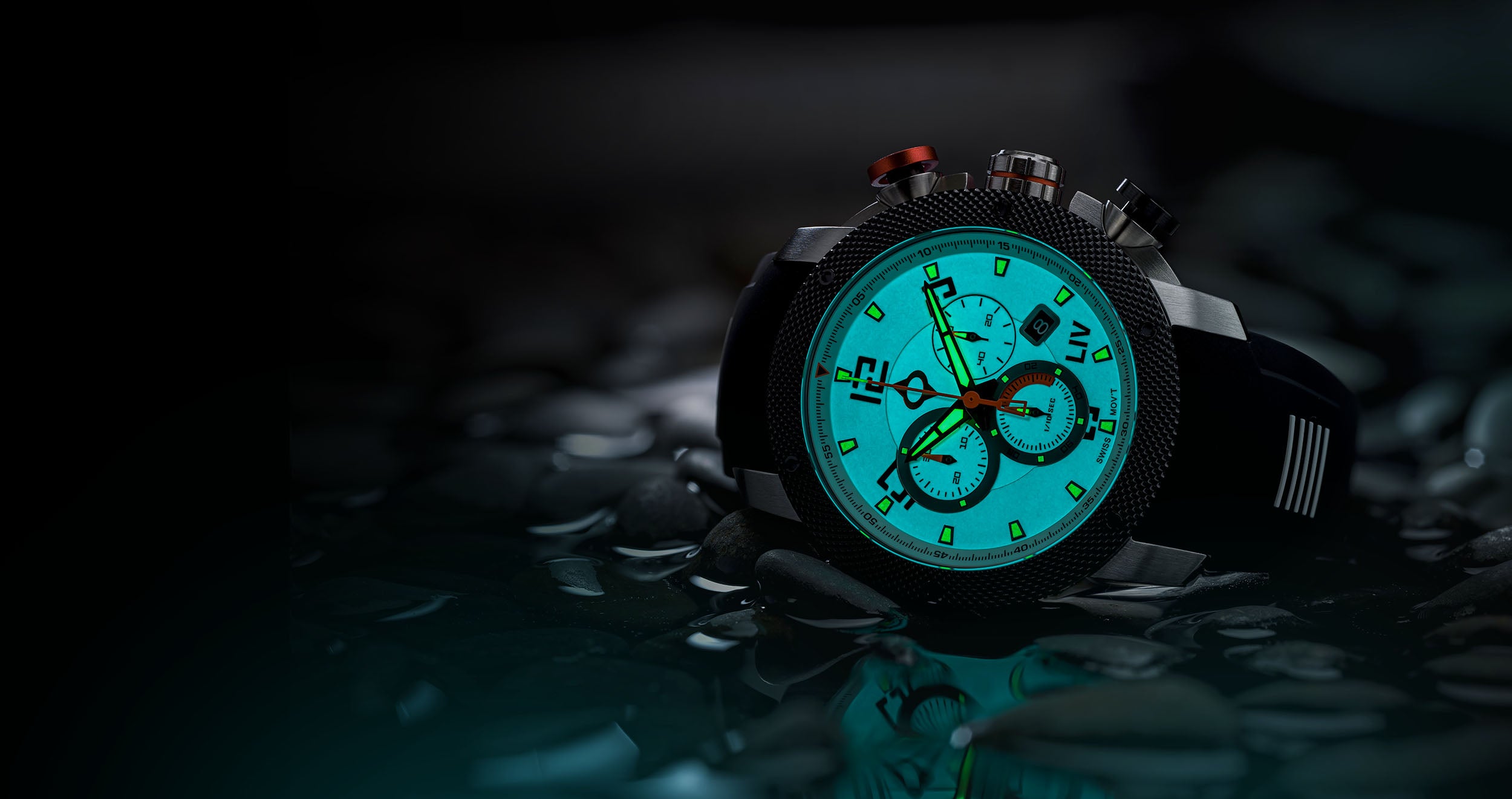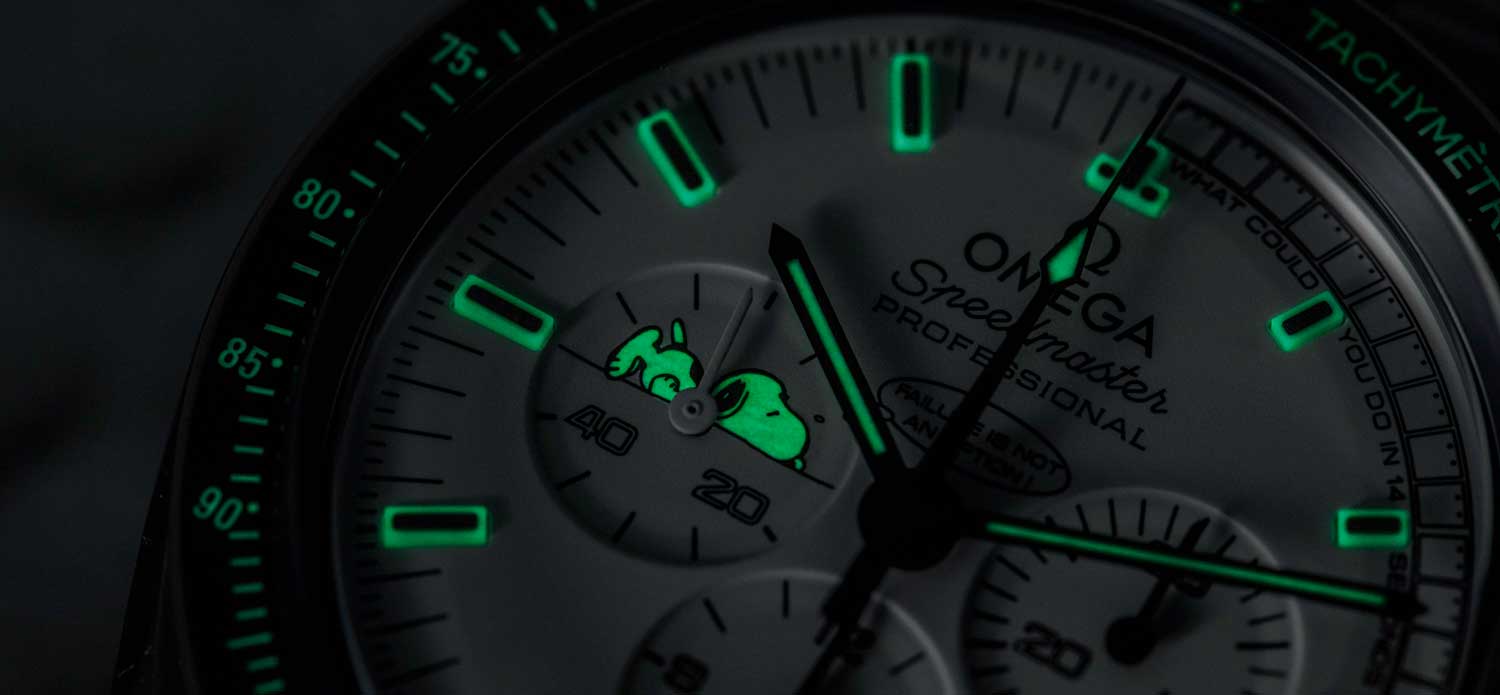In the world of watches, few features capture as much fascination as lume. The glow that allows a watch to remain legible in darkness is not just an aesthetic choice but a carefully engineered material science achievement. Watch enthusiasts often compare three of the most common lume types: C3, BGW9, and Swiss Super-LumiNova. Understanding how these luminous materials work, their differences, and how they are used will help you appreciate what goes into making your watch visible at night.
What is Lume?

Lume, short for luminous phosphorescent pigment, is a compound applied to the hands, hour markers, and sometimes the bezel of a watch to make it glow in the dark. It functions without batteries or LEDs. Instead, it stores light energy from natural or artificial sources and slowly releases it as visible light in dark conditions.
The pigment used today is based on strontium aluminate, a non-radioactive and highly efficient material. When exposed to light, the particles absorb photons and then gradually emit them. This process is called phosphorescence. The glow weakens over time, following a measurable curve known as a charge-decay profile, which shows how brightness fades after initial exposure.
Why Lume Matters in Watches

Lume serves two purposes: functionality and design. Functionally, it allows the wearer to read the time in darkness, underwater, or in low-light environments. This is why strong lume is essential in diver watches, pilot watches, and field watches, where quick legibility can be critical.
Aesthetically, lume gives character to a watch. The color it emits in darkness and the hue it shows in daylight influence the watch’s overall look. Some collectors prefer the classic green tone of vintage watches, while others like the modern, ice-blue appearance of contemporary models.
A Short History of Lume in Watchmaking
The use of luminous material on watches began around World War I, when soldiers needed to read their watches at night. Early lume was made from radium paint, which glowed brightly but was dangerously radioactive. By the mid-20th century, safer compounds like zinc sulfide were introduced, though they produced weaker light.
Modern lume, developed in the 1990s by RC Tritec AG in Switzerland under the name Swiss Super-LumiNova, revolutionized the field. Using strontium aluminate, it became brighter, longer-lasting, and completely non-toxic. Most watch brands today use this material, with variants such as C1, C3, BGW9, and Old Radium differing mainly in color and brightness.
How Lume Works
When light hits the dial of a watch coated with lume, photons excite the electrons in the pigment’s crystal lattice. These electrons store energy and slowly release it over time as they return to their normal state. The released energy appears as visible light, creating the familiar glow.
The glow is strongest immediately after charging and gradually fades. The duration depends on the lume layer thickness, pigment quality, and light exposure time. High-quality lume like Swiss Super-LumiNova can glow for 6 to 10 hours after full exposure.
Understanding Swiss Super-LumiNova
 Swiss Super-LumiNova is the brand name for the premium lume family used by most Swiss and Japanese watchmakers. Every variant in this line uses the same base chemistry but differs in pigment formulation. Each type offers a specific combination of brightness, color in darkness, and appearance in daylight.
Swiss Super-LumiNova is the brand name for the premium lume family used by most Swiss and Japanese watchmakers. Every variant in this line uses the same base chemistry but differs in pigment formulation. Each type offers a specific combination of brightness, color in darkness, and appearance in daylight.
Swiss Super-LumiNova pigments are applied as a fine paste mixed with a binder and then painted or printed onto watch components. After curing, the surface becomes durable and resistant to water, UV light, and temperature changes. These pigments can last for decades without significant degradation if properly applied.
Advantages of Swiss Super-LumiNova:
-
Non-radioactive and long-lasting: Safe for daily wear, unlike older luminous paints.
-
Variety of options: Available in several hues and brightness levels to match watch design aesthetics.
-
Excellent charge capacity: Just a few minutes of light exposure can provide hours of glow.
-
Durable and stable: Retains performance for decades with minimal fading.
Limitations of Swiss Super-LumiNova:
-
Requires light charging: It does not self-illuminate; performance depends on light exposure.
-
Brightness fades overnight: The glow intensity gradually reduces after several hours.
-
Application-dependent: Thicker or uneven coatings may affect uniformity.
C3 Lume Explained

C3 lume is one of the brightest options in the Super-LumiNova range. It is widely used on vintage-styled watches and professional divers.
Daylight color: Light green
Glow color: Bright green
Relative brightness: 100% (the reference standard in brightness)
Advantages of C3
-
Among the brightest available lume compounds
-
Excellent legibility in total darkness
-
Long-lasting glow when fully charged
-
Distinctive vintage tone that enhances classic designs
Limitations of C3
-
The light green tint is visible in daylight, which may alter dial aesthetics
-
Loses intensity more quickly in very dim ambient light compared to BGW9
C3 suits watches that prioritize visibility and tradition, such as diver watches or vintage reissues.
BGW9 Lume Explained

BGW9 is another popular Swiss Super-LumiNova pigment, favored for its modern and neutral look.
Daylight color: White
Glow color: Ice-blue or neon blue
Relative brightness: Around 95% of C3
Advantages of BGW9:
-
Maintains a clean, white dial appearance in daylight
-
Performs better than C3 under dim ambient light
-
Retains glow evenly over time
-
Offers a contemporary, cool-toned glow preferred in modern designs
Limitations of BGW9:
-
Slightly dimmer than C3 when both are fully charged
-
The blue glow may not suit vintage-style watches
BGW9 is ideal for minimal, contemporary watches or those where daytime aesthetics are a priority.
Comparing C3, BGW9, and Swiss Super-LumiNova
|
Feature |
C3 |
BGW9 |
Base Super-LumiNova |
|
Daytime color |
Light green |
White |
Depends on variant |
|
Night glow |
Green |
Blue |
Varies |
|
Brightness |
Highest (100%) |
Slightly lower (~95%) |
Depends on type |
|
Vintage appeal |
Strong |
Low |
Neutral |
|
Modern look |
Moderate |
Strong |
Depends on use |
|
Longevity |
Excellent |
Excellent |
Excellent |
All three use the same underlying technology. The key differences lie in aesthetic preference and brightness curve. Some enthusiasts also prefer mixed applications, such as C3 for markers and BGW9 for hands, to create visual contrast.
Choosing Between C3 and BGW9
There is no universal “best” lume. The choice depends on your design taste and intended use.
-
Choose C3 if you value maximum brightness and a vintage look.
-
Choose BGW9 if you prefer a clean, modern aesthetic with a cool blue glow.
-
Both are backed by Swiss Super-LumiNova, ensuring high durability and non-radioactive performance.
Final Thoughts
Lume is more than decoration; it is a functional and scientific feature that defines the character of a watch. Whether you are drawn to the timeless green of C3, the crisp blue of BGW9, or simply appreciate the innovation behind Swiss Super-LumiNova, understanding these materials reveals the precision that goes into every glowing dial.
The Argos Olympus
 The Argos Olympus combines classic design with dependable mechanics. Featuring a stainless-steel case and sapphire-coated crystal, it’s built for everyday reliability. A watch made to be worn, not stored.
The Argos Olympus combines classic design with dependable mechanics. Featuring a stainless-steel case and sapphire-coated crystal, it’s built for everyday reliability. A watch made to be worn, not stored.
Explore the Olympus now!






